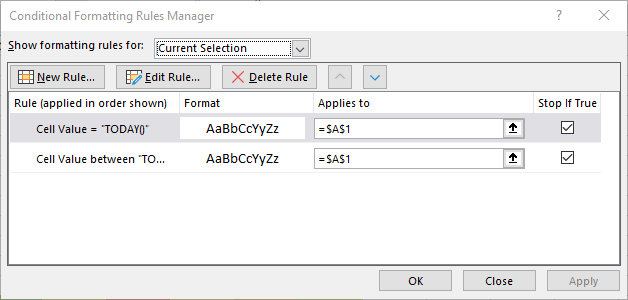Written by Allen Wyatt (last updated November 4, 2023)
This tip applies to Excel 2007, 2010, 2013, 2016, 2019, 2021, and Excel in Microsoft 365
Conditional formats, to Excel, are just like any other format. That means that you can delete them by simply deleting all the formatting in a cell. Follow these steps:
That's it. All the formatting is removed from the cells, including any conditional formatting. If you don't want to delete any explicit formatting in the cell, but instead want to delete just the conditional formats, follow these steps:
If you don't want to delete all the conditional formatting rules, then you need to follow these steps, instead:

Figure 1. The Conditional Formatting Rules Manger.
ExcelTips is your source for cost-effective Microsoft Excel training. This tip (6815) applies to Microsoft Excel 2007, 2010, 2013, 2016, 2019, 2021, and Excel in Microsoft 365.

Create Custom Apps with VBA! Discover how to extend the capabilities of Office 365 applications with VBA programming. Written in clear terms and understandable language, the book includes systematic tutorials and contains both intermediate and advanced content for experienced VB developers. Designed to be comprehensive, the book addresses not just one Office application, but the entire Office suite. Check out Mastering VBA for Microsoft Office 365 today!
Conditional formatting does not allow you to change the typeface and font size used in a cell. You can write your own ...
Discover MoreWhen preparing a report for others to use, it is not unusual to add a horizontal line between major sections of the ...
Discover MoreThere are many times when you are creating a worksheet that you need to analyze dates within that worksheet. Once such ...
Discover MoreFREE SERVICE: Get tips like this every week in ExcelTips, a free productivity newsletter. Enter your address and click "Subscribe."
There are currently no comments for this tip. (Be the first to leave your comment—just use the simple form above!)
Got a version of Excel that uses the ribbon interface (Excel 2007 or later)? This site is for you! If you use an earlier version of Excel, visit our ExcelTips site focusing on the menu interface.
FREE SERVICE: Get tips like this every week in ExcelTips, a free productivity newsletter. Enter your address and click "Subscribe."
Copyright © 2025 Sharon Parq Associates, Inc.
Comments